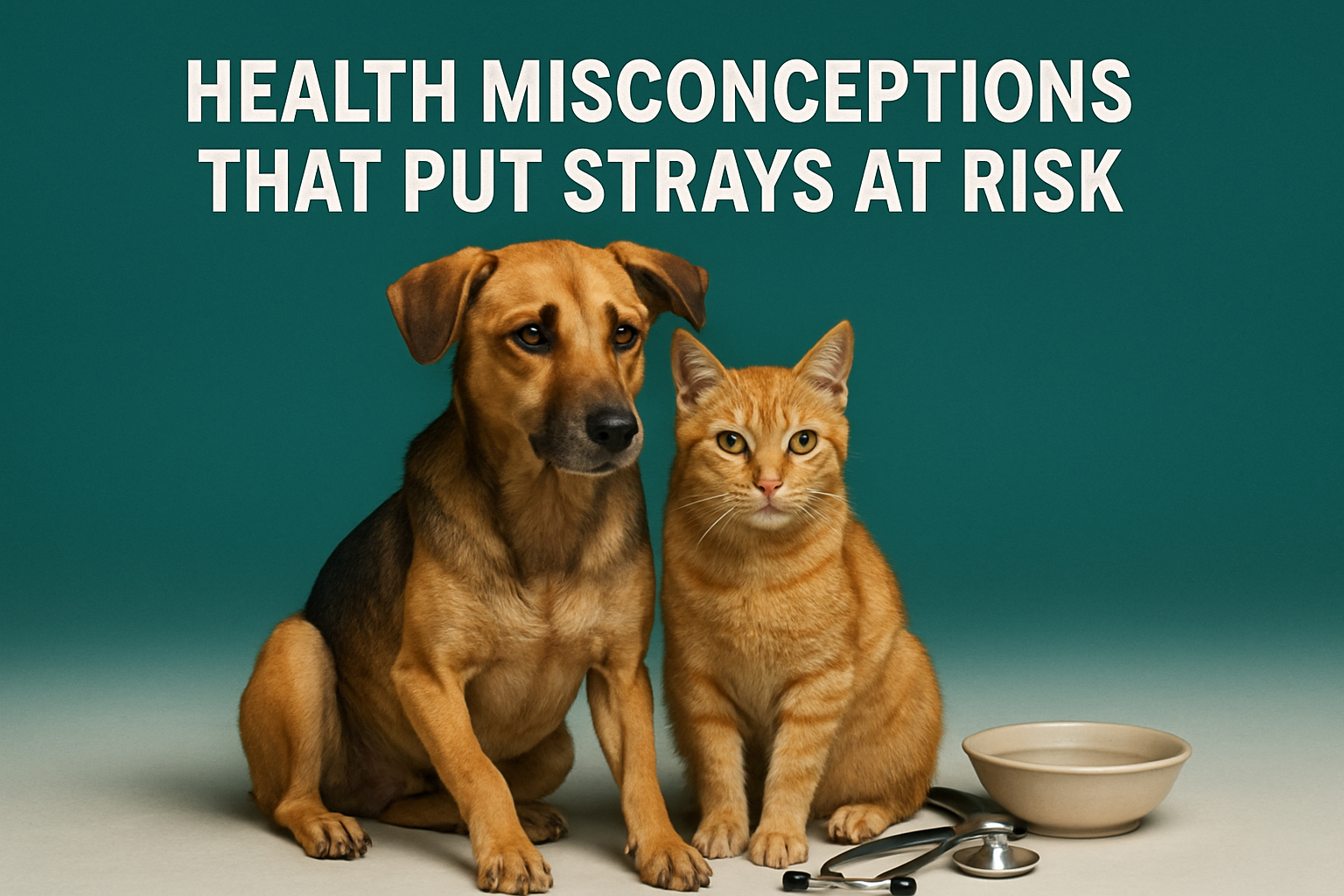Not all who wander are lost—this is especially true of India’s stray animals. Despite living alongside humans on the streets, many myths persist about their behavior, health, origins, and how best to support them. These misconceptions can prevent strays from receiving the care and understanding they need, sometimes putting both animals and communities at risk. Let’s clarify the truth behind common assumptions about strays and explore what they really need to thrive.
The Myth of Aggressive Nature in Stray Animals

One of the biggest things what people get wrong about strays is assuming they're naturally aggressive. This misconception creates unnecessary fear and prevents many from understanding the real story behind street animals' behavior.
Fear-Based Behaviors Are Often Mistaken for Aggression
What appears as aggression in stray animals is usually a defensive response born from trauma or survival instincts. Street animals live in constant stress, never knowing where their next meal will come from or when danger might strike.
When a stray dog growls or shows teeth, they're not displaying inherent hostility. They're communicating discomfort or fear. Many pet owners in India witness this what people get wrong about strays - misreading defensive body language as threats.
These animals have learned that humans can bring both help and harm. Their guarded behavior reflects past experiences, not their true nature.
Gentle Interaction Reveals Their True Nature
Time and patience often uncover a completely different personality in stray animals. Consistent, gentle human interaction gradually breaks down their defensive walls.
Many animal rescuers across India share stories of "aggressive" strays transforming into loving companions once trust develops. This process might take days, weeks, or even months.
What people get wrong about strays extends to expecting immediate trust. These animals need time to understand that not all humans pose threats. Regular feeding, speaking softly, and avoiding sudden movements help build confidence.
Territorial Displays Serve Protective Purposes
Stray animals aren't randomly aggressive - they're protective. When defending food sources, offspring, or safe sleeping spots, their behavior has clear motivation.
A mother cat hissing near her kittens or a dog guarding a food bowl shows natural protective instincts. Understanding this context helps distinguish between genuine aggression and protective behavior.
Creating positive associations through respectful distance and consistent care gradually reduces territorial responses, revealing the gentle nature underneath.
Health Misconceptions That Put Strays at Risk

One of the most damaging things what people get wrong about strays involves their health and care needs. These misconceptions create barriers to helping vulnerable animals and often stem from fear rather than facts.
Disease Fears Lead to Unnecessary Avoidance
Many people assume all strays carry dangerous diseases and avoid them completely. This belief causes unnecessary suffering for countless animals across India's streets. While health concerns are understandable, veterinary evaluations consistently show that most illnesses affecting strays are either preventable or highly treatable with basic care.
Common treatable conditions include skin infections, minor wounds, and parasites - none of which pose significant risks to humans with proper precautions. What people get wrong about strays is thinking that every animal is a health hazard when many simply need basic medical attention.
Feeding Myths Contribute to Poor Nutrition
Well-meaning people often follow misguided feeding advice that actually harms strays. Some believe certain "safe" foods are better when simple, balanced meals would provide far superior nutrition. Others think feeding strays at all worsens population problems.
The reality? Proper nutrition helps strays maintain stronger immune systems and recover from illness faster. What people get wrong about strays includes believing that complex dietary restrictions are necessary when straightforward, nutritious meals make the biggest difference.
The "Naturally Hardy" Myth Prevents Treatment
Perhaps the most harmful misconception is that strays don't need medical care because they're "naturally tough." This thinking leads to neglect of serious wounds, chronic conditions, and preventable diseases that cause immense suffering.
Street animals face the same health challenges as pets - they're simply without consistent care. What people get wrong about strays extends to assuming they can heal themselves when prompt veterinary attention could prevent complications and save lives.
Understanding these misconceptions helps create more effective, compassionate approaches to stray animal welfare.
The Domestication and Abandonment Reality

What people get wrong about strays often stems from assuming all homeless animals were born on the streets. This misconception shapes how we view and approach stray animals, missing the complex reality of their origins and potential.
Many Strays Are Former Pets Who Struggle to Survive
Contrary to popular belief, a significant portion of stray animals are abandoned pets rather than street-born animals. These former companions face unique challenges when forced to live outdoors.
Abandoned pets lack essential survival skills that street-born animals develop naturally. They don't know how to find food sources, avoid traffic, or navigate territorial conflicts with other strays. Many still wear collars or show signs of house training, clear indicators of their domestic past.
Pet abandonment creates particularly vulnerable animals who often approach humans hopefully, only to face rejection or harm. What people get wrong about strays includes assuming all friendly strays are disease carriers, when many are simply seeking the human companionship they once knew.
These former pets frequently benefit most from rehoming efforts since they already understand basic house rules and human interaction patterns.
Socialization Levels Vary Dramatically Among Strays
Street animals display a wide spectrum of social behaviors based on their individual histories with humans. Some approach people eagerly, while others maintain careful distance.
Previously owned animals typically show more confidence around humans, responding to familiar cues like calling or hand gestures. They may follow people, sit on command, or show excitement at seeing potential adopters.
Conversely, animals born on streets or those who experienced trauma often display wariness. This doesn't make them aggressive—just cautious. What people get wrong about strays includes interpreting this natural caution as inherent aggression or unsuitability for homes.
Understanding these behavioral differences helps determine the best approach for each animal, whether that's immediate rehoming or gradual socialization work.
Adult Strays Can Successfully Transition to Home Life
Another common misconception suggests only young animals adapt well to domestic life. Adult strays, including seniors, regularly adjust to loving homes when given proper support.
Mature animals often make excellent pets because their personalities are already established. They're past the destructive puppy or kitten phase and often show deep gratitude for comfort and care.
What people get wrong about strays extends to believing older animals carry too much baggage for successful adoption. With veterinary care addressing health issues and patient introduction to home routines, adult strays frequently become devoted companions.
The key lies in realistic expectations and commitment to helping them adjust. Many adult rescues bond strongly with their new families, seemingly understanding they've been given a second chance at happiness.
Feeding and Care Approaches That Actually Help
What people get wrong about strays often centers on the belief that feeding them creates more problems. In reality, community caregivers and feeders play a critical role in keeping stray populations vaccinated, sterilized, and less aggressive. The challenge isn't whether to help strays, but how to do it effectively.Consistent Feeding in Set Locations Fosters Trust
One major thing what people get wrong about strays is assuming random feeding helps equally. Structured feeding programs make all the difference.
When you feed strays at the same location and time daily, you reduce territorial disputes and resource competition. This consistency helps stray animals develop trust with humans, making them easier to approach for medical care or sterilization procedures.
Random feeding across different areas actually increases stress among stray populations. Animals spend more energy searching for food and competing aggressively with other strays.
True Welfare Requires Comprehensive Health Management
Another aspect of what people get wrong about strays involves thinking food alone solves their problems. Effective stray care demands a holistic health approach.
Beyond regular meals, strays need parasite control, vaccination schedules, and reproductive management to thrive. Without addressing these medical needs, fed strays can still suffer from preventable diseases and continue reproducing rapidly.
Quality nutrition supports their immune systems, but only when combined with proper veterinary attention. This includes treating wounds, managing skin conditions, and ensuring they receive essential nutrients for coat health and overall wellbeing.
Community Programs Create Lasting Solutions
What people get wrong about strays extends to individual versus collective action. Coordinated community efforts produce better outcomes than isolated feeding.
Successful Animal Birth Control (ABC) programmes require at least 70% sterilization rates in target areas. Communities that organize Trap-Neuter-Return programs alongside feeding schedules see significant population stabilization.These collaborative approaches address what people get wrong about strays by tackling root causes rather than symptoms. When neighborhoods work together on structured care, they create safer environments for both animals and residents while preventing overpopulation from spiraling out of control.
Conclusion
Common misconceptions about stray animals hinder meaningful support and humane solutions. Fact-based understanding reveals that most strays benefit from consistent care, medical attention, and responsible community involvement. By moving beyond myths about their behavior, health, and adaptability, people can help strays thrive alongside them.
Want to help street animals more effectively? Connect with local animal welfare organizations for guidance on safe feeding, access to veterinary care, and community support programs to improve the lives of strays in your area.





